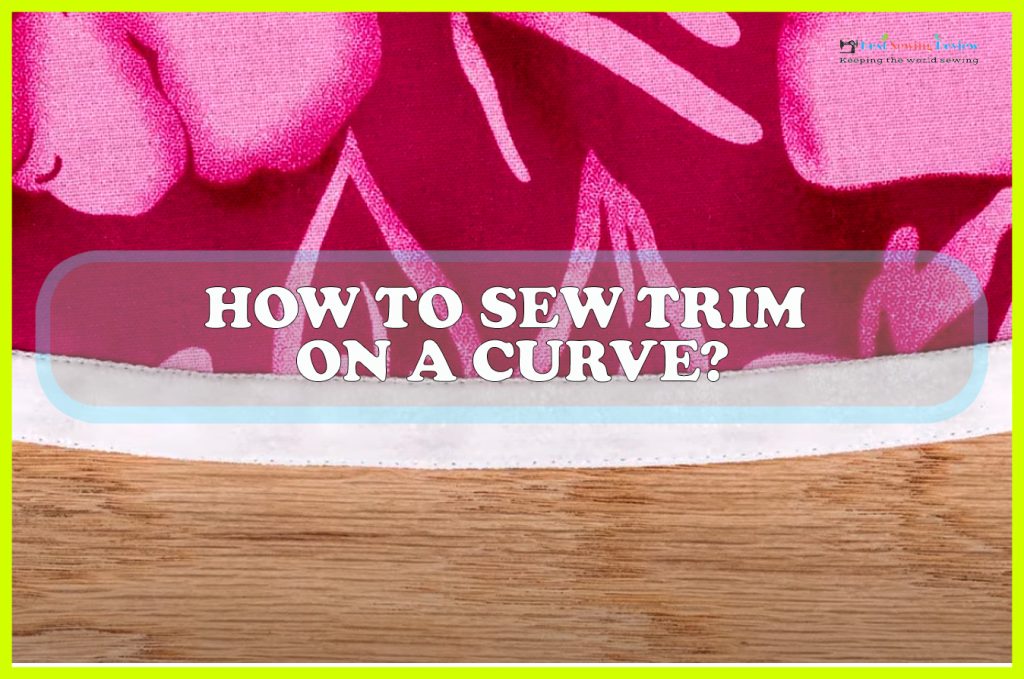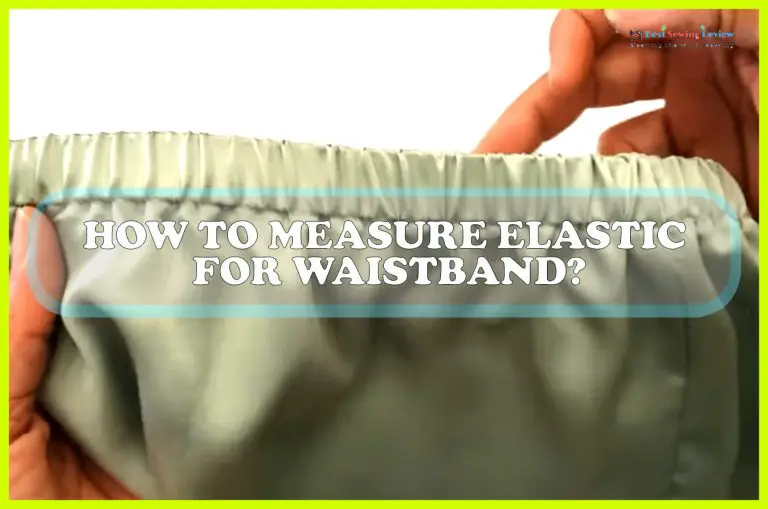Sewing trim on a curve can be challenging, but there are a few things you can do to make it easier. First, use a sharp needle and thread that is strong enough to hold the trim in place. Second, take your time and go slowly around the curve.
Third, pin the trim in place before sewing it to help keep it from moving around. Finally, use a zigzag stitch or other decorative stitch to sew the trim in place. With a little practice, you’ll be able to sew trim on a curve like a pro!
- Pin the trim to the fabric, aligning the raw edges
- Sew the trim to the fabric using a straight stitch, removing the pins as you go
- Cut away any excess trim, leaving a small seam allowance
- Finish the edge of the trim with a zigzag stitch or serger for extra durability

How Do You Sew Curved Trim?
When it comes to sewing curved trim, there are a few things you need to keep in mind. First, you need to make sure that your fabric is stretched tautly over the curve. Secondly, you need to use a very sharp needle so that you can get a clean and precise stitch.
And lastly, you need to take your time and sew slowly so that everything turns out perfectly. Let’s go over each of these points in more detail. To start, you need to stretch your fabric tautly over the curve.
This will help prevent any puckering or gathering when you sew. You can do this by holding the fabric in place with one hand while gently pulling it tight with the other hand. Once your fabric is nice and tight, you’re ready to sew.
Next, switch to a sharp needle. This is important because a dull needle will cause your stitches to be less precise and could lead to tears in the fabric. If possible, use a size 10 or 12 needle for best results.
Now it’s time to start sewing! Sewing slowly is key when working with curves. take your time and focus on making small, even stitches.
If you rush, it’s easy to end up with crooked or uneven stitching lines. When you’re finished sewing, lightly press the trim with an iron if necessary (this will help set the stitches). And that’s it – you’ve successfully sewn curved trim!
How Do You Sew a Curved Edge?
Sewing a curved edge can be tricky, but there are a few different ways that you can do it. One way is to use a method called bias binding. This involves cutting strips of fabric on the bias (45-degree angle from the selvage), and then sewing them around the curves of your project.
Bias binding is great for projects with lots of curves, like quilts or garments with ruffles. Another way to sew a curved edge is by using stay stitching. This involves stitching around the curve of your fabric before you cut it, which helps to keep the shape in place.
Stay stitching is best for smaller curves, like those found on collars or sleeve openings. If you’re working with a particularly difficult curve, you may need to pin the fabric in place before sewing. Start by basting (or hand-sewing) along the curve, then remove the pins and finish sewing with your machine.
This method takes a bit more time, but it’s worth it if you want your finished project to look its best.
How Do You Sew Fabric on a Curve?
If you’re sewing fabric on a curve, the best way to do it is by using bias tape. Bias tape is strips of fabric that are cut on the bias, which means they’re cut at a 45-degree angle to the grain of the fabric. This makes them stretchy, so they can easily conform to curves.
To sew bias tape onto a curve, start by ironing it in half lengthwise. Then, open up the tape and pin it to your fabric, starting in the middle and working your way out. Once it’s all pinned in place, sew along the edge of the tape with a straight stitch.
If you don’t have bias tape or if you want your stitches to be less visible, you can also use a curved stitch on your sewing machine. To do this, set your machine to its longest straight stitch setting and sew slowly around the curve.
How Do You Hem a Curved Line?
When you are hemming a curved line, the first thing that you need to do is to mark the fabric. You can use a chalk pencil or a Hera marker to do this. Once the fabric is marked, you will need to cut off the excess fabric.
Make sure that you leave a seam allowance of at least 1/2 inch. After cutting off the excess fabric, you will need to pin the fabric together. Start by pinning at the center of the curve and then work your way out.
Once the fabric is pinned together, you can start sewing. Use a zigzag stitch or a serger stitch to sew along the curve.
Inserting a Trim on Straight and Curved Edges
How to Sew a Curved Hem Without Puckering
Sewing a curved hem can be tricky- you want it to lay flat and not pucker. Here are some tips to help you get a perfect curve every time: -Start by cutting your fabric on the bias.
This will give you more flexibility when sewing and prevent the fabric from stretching out of shape. -Use a rotary cutter and mat for clean, precise cuts. -Mark your fabric with chalk or a water-soluble pen before cutting so you know where to sew.
-Once you’ve cut your fabric, use pins or weights to hold down the edges while you sew. This will keep everything in place while you work. -When sewing, take small stitches (about 1/8″) and go slowly around the curve.
You may need to stop and start a few times to get things just right, but that’s okay! Just be sure to backstitch at the beginning and end of each section so your stitches don’t come undone.
How to Sew a Curved Hem on Stretchy Fabric
If you’re looking to add a little extra flair to your next sewing project, consider adding a curved hem. This type of hem can be especially striking on stretchy fabric, as it adds both visual interest and definition to the garment. Here’s a step-by-step guide on how to sew a curved hem on stretchy fabric:
1. Begin by cutting your fabric to the desired length, plus an extra inch or two for seam allowance. If you’re working with a patterned fabric, you may want to cut along the selvage edge to ensure that your pattern remains straight. 2. Next, fold over the top edge of the fabric about ½ inch and press in place.
Then, fold over again so that the raw edge is hidden and press once more. Repeat this step for the bottom edge of the fabric. 3. To create the curve at the bottom of the garment, start by folding up one side about 1-2 inches and pinning it in place.
Then, do the same thing on the other side until you have created a gentle curve at the bottom edge of your garment (see photo). 4. Once you’re happy with the shape of your curve, sew along both sides using a stretch stitch or zigzag stitch (this will help prevent breakage when stretching out the finished garment). Be sure to backstitch at each end to secure your stitches!
5. Finally, finish off your seams by serging or using bias tape (optional). And that’s it – you’ve successfully completed sewing a curved hem on stretchy fabric!
How to Sew a Curved Edge
If you’re looking to add a little something extra to your next sewing project, why not try sewing a curved edge? It’s a great way to add interest and variety, and it’s not as difficult as you might think! Here’s how to do it:
1. Start by cutting your fabric into the desired shape. To ensure that your curves are nice and smooth, use a rotary cutter and mat.
2. Once your fabric is cut, it’s time to start sewing!
Begin by stitching along the straight edges of your fabric first. Then, when you get to the curve, simply sew slowly and carefully around it.
3. When you’ve finished sewing the curve, trim away any excess fabric (being careful not to cut too close to your stitches).
You can also finish off the raw edge with bias tape or binding if you like.
And that’s all there is to it! Now you know how to sew a curved edge onto any fabric project.
Give it a try on your next project – we think you’ll love the results!
How to Change a Straight Hem to a Curved Hem
If you’re looking to add a bit of flair to your straight-hemmed garments, why not try changing it up to a curved hem? It’s a simple alteration that can make a big difference in the overall look of your clothing. Here’s how to do it:
1. Start by cutting off the existing straight hem. You’ll need enough fabric to work with, so make sure to leave yourself some extra room. 2. Next, mark out the desired shape of your curved hemline with chalk or a fabric marker.
This doesn’t have to be perfect – you can always adjust as you go along. 3. Using a sewing machine or needle and thread, sew along the marked line. Start at one side seam and work your way around until you reach the other side seam.
4. Trim away any excess fabric, being careful not to cut too close to your stitches. Press the newly sewn curve into place and voila! You’ve now got a beautiful new curved hem on your garment.
Conclusion
In this blog post, the author shows us how to sew trim on a curve. This is a great technique to use when you want to add a bit of extra flair to your sewing projects. The first step is to mark the center of your trim and the center of your fabric.
Next, you will need to pin the trim in place. Once the trim is pinned, you can start sewing it onto the fabric. Start by sewing along the edge of the trim, and then work your way in towards the center.
When you get close to the end, you may need to snip off some of the excess trim so that it lays flat against the fabric.

